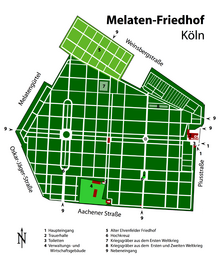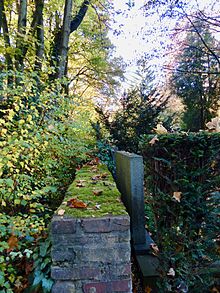Old Ehrenfeld cemetery
The old Ehrenfeld cemetery on Weinsbergstrasse was laid out in 1870 as a communal cemetery of the then independent community of Ehrenfeld, adjacent to the Cologne cemetery Melaten , after the citizens of Ehrenfeld were denied burial in the Melaten cemetery by a Cologne council decision. The formerly independent Ehrenfeld cemetery, which is now integrated into the Melaten cemetery, was placed under monument protection on July 1, 1980 .
Historical background
The dead of the Ehrenfeld community were buried in the St. Mechtern churchyard until the middle of the 19th century . Due to the population growth at the beginning of the 19th century, it became necessary to create a new burial place. In 1824 a cemetery was opened on the corner of Venloer Strasse and Alpener Strasse (today Alpenerplatz), where the Ehrenfelders could bury their dead. Already 30 years later, the Ehrenfeld deceased had to be buried in the cemetery on Feltenstrasse in Bickendorf for capacity reasons . On February 6, 1867, the Ehrenfeld community submitted a request to the Cologne City Council to bury the deceased in the Melaten cemetery. The City Council of Cologne rejected the request on the grounds that each municipality had to create appropriate burial facilities itself. In 1869, planning began for the communal Ehrenfeld cemetery in the immediate north of Melaten. The right-angled system of paths was not based on the paths on Melaten, but on the direction of Ehrenfelder Kirchhofstraße (from 1903 Weinsbergstraße). The two cemeteries were originally separated from Widdersdorfer Straße. Later, Widdersdorfer Strasse - renamed Terrassenweg - ended on Mechternstrasse. A wall between the two cemeteries and a different height level still document the different conception of the original layout of the two cemeteries.
On July 31, 1870 the Catholic part of the Ehrenfeld cemetery was inaugurated. According to the cemetery regulations of February 11, 1870, the deceased were buried in the cemetery separated according to denomination . The original Ehrenfeld cemetery stretched from Geisselstrasse to Mechternstrasse. Ten years after the inauguration, it became necessary to plan an expansion of the cemetery. In 1885 the cemetery was expanded to its present size in a westerly direction. The original plan was to build a neo-Romanesque mourning hall for the cemetery . However, this project did not materialize. In 1895 the administration, including the new planting and planting of the graves, became the responsibility of the Melaten cemetery.
The listed buildings and small monuments include the porter's house at the entrance to Weinsbergstraße, the cemetery wall, some of which is still made of original bricks, and the high cross, as well as a medieval grave slab that was found during reconstruction work on the high cross.
The single-storey, slate- covered gatehouse was built in 1914 according to the plans of Hans Verbeek next to the wrought-iron gate of today's main entrance. The original main entrance used to be further southeast. The high cross, which was made in 1868 based on a design by Vincenz Statz , is one of the original furnishings of the cemetery . The square high stele is crowned by a cross and shows on the pedestal the inscription “Blessed the dead - Those die in the Lord. Offg. 14.14 "supplemented on the left by the inscription" Gift from Jac (ob) Wahlen in Cöln 1868 ". During the renovation of the Hochkreuz in the 1990s, a medieval heraldic grave slab from the early 15th century was discovered in the foundation area, which presumably came from St. Mechtern and was used as a second use in the construction of the Hochkreuz.
In the cemetery is the grave of the Cologne cycling world champion Albert Richter , whose parents' house was within walking distance on Sömmeringstrasse. In 1940 Richter was allegedly a victim of the Gestapo .
Tombs on the Ehrenfeld cemetery
In 2010, as part of a monument preservation appraisal, 57 monumental grave monuments were identified in the old Ehrenfeld cemetery, 16 of which date from the 19th century. Most monumental tombs are in the form of steles (15), crosses and cross steles (18). Up until the 1920s , galvanoplastic figures in the form of angels and mourning women were set up as grave sculptures , mainly by the Galvanoplastische Kunstanstalt in Geislingen an der Steige .
Some of the gravestones in the cemetery are of cultural and historical significance and were made by well-known local and national artists such as Antonio Gobbo , Wilhelm Fassbinder , Emil Rudolf Mewes or Peter Hecker .
- Monumental tombs
Individual evidence
- ↑ Johannes Maubach, Marianne Vogt-Werling, Michael Werling: Der Friedhof Ehrenfeld - Monuments and Personalities , Cologne 2011, p. 12
- ↑ Picture book Cologne - Memorial former cemetery: Feltenstr., 50827 Cologne - Bickendorf (around 1855). In: www.bilderbuch-koeln.de. Retrieved November 2, 2016 .
- ↑ Detlef Rick: Melaten - graves tell city history . 2nd Edition. Emons, Cologne 2010, ISBN 978-3-89705-789-0 , p. 14th f .
- ^ Report on the status and the administration of the community affairs of the city of Cologne 1895 , p. 131.
- ↑ Johannes Maubach, Marianne Vogt-Werling, Michael Werling: The Ehrenfeld cemetery - monuments and personalities . Cologne 2011, p. 17th f .
literature
- Johannes Maubach, Marianne Vogt-Werling, Michael Werling: Der Friedhof Ehrenfeld - Monuments and Personalities , Cologne 2011, 192 pp.
Web links
- friedhof-ansichten.de: Old Ehrenfelder Friedhof
- Kölner Stadt-Anzeiger: The approach to the cemetery should be more convenient
Coordinates: 50 ° 56 ′ 34.3 " N , 6 ° 54 ′ 58.3" E










